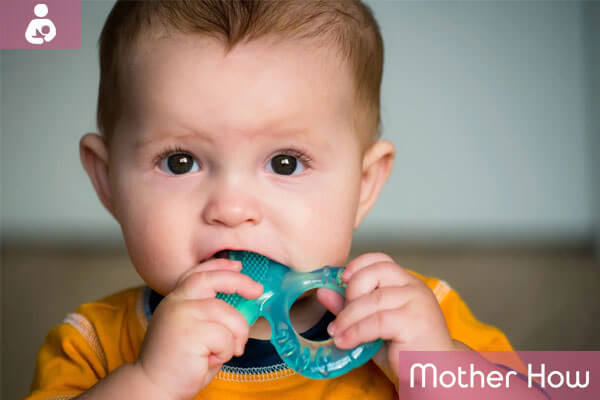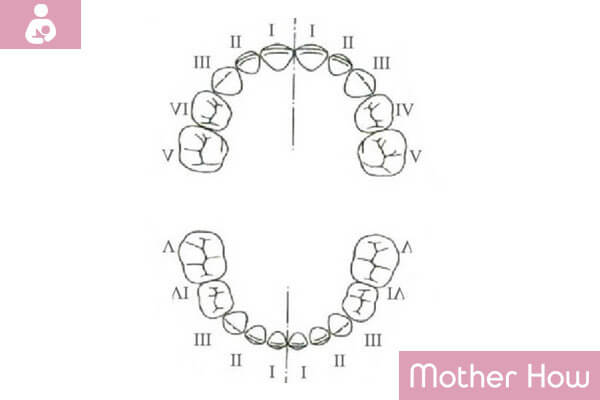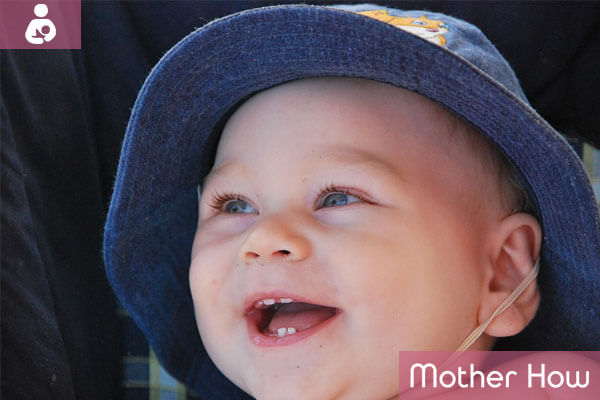Terms of teething can be defined by both the biological and registered age of a child. The development and terms of teething depend on inherited genetic factors, in other words, how the teeth appeared not only in the parents’ mouths but also in the grandparents’. However, the internal and external causes can affect teething as well. For example, climate, the course of pregnancy, complications during pregnancy and delivery, child and mother’s nourishment after the birth, quality of drinking water, child’s illnesses during the first months after the birth, etc. Because of all these, terms of deciduous teething vary in different regions. The hotter climate is the earlier teeth usually erupt, though that’s not axiomatic.
Symptoms of Teething of a Child
How to find out if the first tooth is coming? The symptoms of teething are changes in the child’s mood, troubled sleep, and possible loss of appetite; if the baby is being breastfed it more often requires breast at night, can bite the breast a little while eating, and tries to put anything in its mouth. In the oral cavity flushed, inflamed gums and possibly a small white swollen ball, outside which the tooth will appear, can be seen. Though it can keep waiting: before finally appearing in the mouth, the tooth must come through the bone that encircles it, and then through the mucous membrane of the gum.
Does teething need any help? You shouldn’t interfere with the natural process because baby teeth essentially appear in the mouth by themselves, without extra effort or outside help. Don’t aggravate the baby’s gums by rubbing them with a piece of sugar or a spoon handle as it was done some time ago. This way you can damage tender baby teeth and bring an infection into the jaw bone. Be careful with doughnuts, crusts of bread, and bagels: their crumbs may stick in a child’s respiratory tract.

Within one’s lifespan 20 deciduous teeth change into 20 permanent teeth, and the rest 8-12 teeth don’t change – they erupt initially permanent.
Specific Teething Terms
- Central incisors – 6-9 month
- Lateral incisors – 9-12 month
- First molars – 12-19 month
- Canine teeth – 16-22 month
- Second molars – 20-36 month
It should be mentioned that this is only approximate data. Statistically, the first tooth appears in the mouth of a modern baby by eight and a half months. So the terms of appearing of the rest of the teeth shift. Dentists consider that the later the first tooth’s appeared the later deciduous teeth will drop out. But by the age of one, the baby should have at least one deciduous tooth, otherwise, the baby must be ill: For example, it can be rachitis or hypothyroidism.
The first tooth can appear simultaneously with the second, and the coming of other teeth can be the same – this is called the “twoness principle”. In some cases, the baby can have 4 teeth at once. Of course, such “numerous” teeth growth has an influence on terms of teething. The situation is also unclear with the order of teething; you are unable to affect it, so don’t worry about anything, it’s a natural process after all.
By the age of three, the baby teeth have appeared fully in the mouth, and by the age of six, they begin gradually change to permanent.
There are 20 deciduous teeth altogether: 4 incisors (4 central teeth), 2 canines (3rd from the center), and 4 molars (4th and 5th from the center “chewing” teeth).
An adult normally has 28-32 permanent teeth, on each jaw, there are 4 incisors, 2 canines, 4 premolars, and 4-6 molars, children don’t have premolars. The development of the third molar (“wisdom tooth”) may not ever take place because of the inherent adentia (absence of tooth rudiment) of third molars, what’s also considered normal. There is a possibility for a different situation: the “wisdom tooth” lies in the jaw-bone but never becomes visible in the mouth because of its irregular position or the lack of room for it on the jaw. This happens quite often.
After appearing of all deciduous teeth there are no gaps, intervals between them, and it’s normal. But as the jaw grows, before deciduous teeth change for permanent, approximately at the age of four the gaps between baby teeth should appear. This process is necessary because permanent teeth are bigger in size than deciduous teeth and if the gaps are not formed permanent teeth don’t have enough room to be placed correctly and the child gets “crooked” permanent teeth. Permanent teeth can’t form a straight row during teething, they become dense, the process of chewing food is disrupted and that requires a course of treatment from an orthodontist.

At the same time with the formation of gaps between the deciduous teeth, the resolution of the baby teeth’ roots begins, after that, the teeth one by one get loose and fall out. There is even a tendency to buy a golden or silver box and keep the baby’s first teeth there.
A common opinion about regular terms of teething doesn’t exist because scientific research was carried out by various authors in different regions and different years of the past and present century. Moreover, boys are usually a little behind in progress the girls, and this argument isn’t used when constructing a table.
The Questions often Asked by Concerned Mothers
What do you need to do if the teething doesn’t begin in time?
Nothing. There’s no exact definition of “late teething” or, rather, “terms of teething” are relative, generally accepted terms, not firm data. These terms are determined according to average values and depend on neonatal (how the childbirth’s gone) parameters, physical constitution, individual characteristics of the child, etc. So, whenever baby teeth appear, that very term is normal for a child. By the way, this rule also applies to permanent teething and “wisdom teeth”, which may not appear at all.
The later teeth appear – the healthier they are?
Unfortunately, that’s not true – terms of teething and their “quality” are not interdependent. Recently there have been two points of view considering this issue: one of them says that the sooner the tooth becomes visible, the less it acquires mineral substances because primary mineralization takes place deep in the jaw-bone. But this opinion doesn’t take into account possible displacement in terms of teething because of acceleration.
What sedatives can be given to children when the teething begins? Do these medications affect the teething process?
No, these medications don’t affect deciduous teething. All of them passed clinical approbation and of course, don’t have any side effects. The only complication is an allergy, but even for children prone to it, there is a sedative – Dr.Baby, which doesn’t contain lidocaine. Almost all such medications contain lidocaine and inert components (menthol for cooling, taste improvers, and astringent substances).
How often may sedatives be used?
Don’t use the sedatives on schedule (as, for example, antibiotics). If there’s any pain – use the gel, if there isn’t – don’t. But don’t get too accustomed to them, you shouldn’t use the medication more than 3-4 times a day and you’d better not apply the gel more than three days in a row. If you apply sedatives too often they can cause adaptation and won’t be effective anymore. Besides, all such gels are medications, you should remember it! If you can manage without them, you’d better do it.
How can the teething be hastened?
Certainly not with medication. An approved means is gentle massage. Rub the gum carefully with a clean finger – the baby will feel better, and the tooth will appear in the mouth a bit sooner. But don’t push too hard to avoid trauma. The baby is usually given a cold spoon to suck, but you can also put a dummy in the fridge for a short time and then offer it to a child. There are specifically made “eruptions” filled with cold liquid. You put them in the fridge and then give them to the child to gnaw. But don’t overdo it!
Can bad breath appear while teething begins? What’s the reason?
When teething begins, the mucous membrane partially decomposes (lysis). The enzymes of saliva take the main part in this process. It’s well-known that the number of saliva increases during teething. It’s bound up with lysis. With all this going on, the viscidity, color, and scent of saliva indeed can change. Besides, saliva contains mild antibacterial substances, which prevent infection of the wound, formed as a result of teething. Their influence can also change the natural characteristics of saliva. In addition to it, a small amount of blood gets into the mouth, and its decomposition can be the cause of an acidulous (metallic) scent. But you’d better be cautious and ask the doctor about it – an unpleasant scent may indicate problems with the gastrointestinal tract, after all.
What should I do if during the teething the temperature has raised?
A slight increase in temperature during teething is normal. But it won’t reach 102,2-104°F. Attention: teething shouldn’t cause high fever, diarrhea, vomit, total loss of appetite, convulsions, and asphyxia. If these symptoms occur, and even if you think it’s because of teeth, immediately consult a physician. It’s not advised to give the baby febrifuge and anesthetic (syrup, suppository) without consulting a doctor and when the body temperature is less than 101,3°F.
How to tell a fever caused by teething from a fever caused by another reason? How long may the fever last while teething goes?
It’s all personal, and unique, but in general, elevated temperature and diarrhea are merely secondary indications of teething. It’s a hard physiological crisis for such a small being. Nowadays most pediatricians and physiologists admit that fever during teething is most likely a reaction to the inflammation of the mucous membrane of the oral cavity.
The teething causes irritation in the mouth, often a wound (due to the friction and lysis), which sometimes becomes infected. So, hyperthermia is caused not by the mechanism of teething, but by its the side-effects of it. One of the arguments for this opinion is that during the permanent teething, despite the similar histological and physiological changes, there are little to no such symptoms.
The appearance of fever and diarrhea can be explained by abrupt changes in diet, foreign bodies in the mouth, and disturbance of microflora, as well as the weakening of local immunity in the nasopharynx. From this, it follows that if high body temperature and liquid stool last for too long (for more than 72 hours) the teething is probably not the reason.

Distinctive Features of Baby Teeth Possible at the Stage of Teething
- Broadening of gaps between the teeth. It can indicate intensive growth of jaws and the transition period from deciduous teeth to permanent is considered normal. A wide gap between front incisors on upper law usually means that the fraenum is situated deep. The tactics of medical observation and treatment of the wide gap are determined by an orthodontist.
- A blackish rim on the neck of a tooth may appear due to the use of soluble iron medications or a chronic inflammatory process (precipitation of bacteria Leptotrichia).
- Russet coloring of teeth is often related to the consumption of antibiotics by the mother during the second half of pregnancy or by the baby during the teething period.
- A yellowish or greenish coloring of enamel is developing due to the severe dysfunction of bilirubin exchange and hemolytic (disruption of red blood cells) conditions.
- A Reddish coloring of enamel is typical for hereditary metabolic dysfunction of porphyrin. This disease is called porphyria.
- Bite anomalies originate from uneven development of jaws, from long use of dummies (but not from breastfeeding).
- Irregular position of teeth is caused by constitutional characteristics (small jaws), trauma, hereditary disorder of the exchange of conjunctive tissue, and tumors of the alveolar process.
- The absence of teeth till 1 year is rarely connected with adentia – the absence of rudiments of teeth (most often it is the front group of teeth). The existence of teeth’ rudiments can be checked by radiovisiography, appointed by a dentist. The radiograph, on which all the teeth and the rudiments can be seen, is an argument for a conclusion about the existence of rudiments and the extent of readiness for the teething.
Atypical Situations
The timely and orderly growth of teeth indicates the normal development of a baby’s organism. It is a physiological process, in direct connection with the general condition of a baby’s health. Consider some atypical situations, which can indirectly indicate pathology. However, only indirectly. It should be mentioned that only a thorough checkup can confirm or refute these assumptions.
Delay of the terms of teething (more than for 1-2 months from normal) may be the consequence of rachitis, infectious disease, long-term intestines dysfunction, and metabolic changes. But only in the case when the baby was born on term, pregnancy and delivery were taking their normal course, and the baby is healthy and has never been ill.
Hastened deciduous teething (1-2 months earlier than normal) may be evidence of endocrine disturbance.
Breach of the order of teething, the absence of one or another tooth may also be the result of health anomalies (there are isolated cases when even rudiments of teeth are absent) or the consequence of diseases endured by the mother while being pregnant.
The teething outside the dentition arc may be caused by an irregular position of the axis of the tooth (horizontal or slanting). Besides, there are situations when during the laying of teeth not one, but two rudiments are put. Such teeth are called “supernumerary”, they usually appear simultaneously and disrupt the whole dentition structure. It’s more typical for permanent teeth and in most cases requires an orthodontist’s treatment.
Incorrect forming of the tooth itself – size, shape, position, color, lack of enamel, etc. The causes of these occurrences should be analyzed by an expert.
The appearance of teeth before birth. Such situations are extremely rare. Such teeth interfere with the breastfeeding of the child, so they are usually extracted.

Some Things You Should Remember During Deciduous Teething
Clean your baby’s face routinely with a specific towel to remove saliva and prevent irritation of the skin. You’d better not rub the baby’s face, but gently dry the saliva in order not to cause irritation around the mouth.
Put a clean plain tissue under the baby’s head for the absorption of flowing saliva. When the tissue gets wet you won’t need to change the bed-sheet.
Give the child something to gnaw at. Make sure that it’s a big enough item so that the baby won’t swallow it or crack it with his teeth. The rings specially made for teething are sold in drugstores and online and are in fact quite effective.
If you use them, don’t freeze them in the fridge until they turn into ice, it can damage delicate gums. Never tie the teething ring to the baby’s neck so that it won’t get tangled in a ribbon. Rub the gums gently with a clean finger wrapped in a bandage or clean gauze. On no condition put aspirin or other pills on teeth; don’t rub alcohol-containing solutions into the gums. If your baby is feeling unwell, an appropriate dose of paracetamol can help. But, first of all, consult with a doctor!
When the teeth appear, they need tending. A baby younger than 1-1,5 years can have its teeth cleaned with a specific toothbrush made of silicon (it is put on the mother’s finger) once a day. It’s convenient to seat the baby with its back to the mother on her knees during the action.
For a baby not so young (older than 1-1,5) you may buy the first child’s toothbrush of a convenient size and with durable bristles. Pay attention to the marking on the package while making your choice – there should be specified age, which is appropriate for the usage of the toothbrush. During this age, children are readily copying adults, and the routine of brushing teeth in the evening is easily set.
It’s understandable that the baby is just playing with “brushing the teeth” so far, and the mother tends to it – the most comfortable position is to stand behind the child in front of a mirror. At two, the child may learn how to rinse the mouth with water (better do it after each meal) and use the child’s toothpaste. Perhaps you will have to try a number of the toothpaste of different brands before the child approves of the taste.
Among other precautions against caries (deciduous teeth are more fragile than permanent, and become stricken in shorter terms) – control of the amount of candy in the child’s diet and absence of sweet drinks (juice, for example) before going to bed and during the night.
The child should be brought to the dentist for the first time at the age of one year. But if you’re concerned about something – a disrupted order of the teething, change of coloring of enamel, spots on the tooth, bad breath; – consult with the dentist as soon as possible. Healthy deciduous teeth are a guarantee of healthy formed and erupted permanent teeth.
How to Prevent Caries
Don’t lick the dummy and don’t try the food with the baby’s spoon! By doing so you will protect the baby from bacteria contained in the adult’s saliva.
Lessen the amount of sugar in the child’s diet as much as possible. Offer fresh juice of water instead of sweet drinks and never give a sweet drink as a sleeping draught before going to bed.
Teach a one-year-old child to drink a few sips of water after the meal, and at the age of two – to rinse the mouth after every meal.
Take the child to the dentist on schedule. For the first time at the age of one year. If the problems arise earlier, don’t delay a visit to a doctor. Check up your child’s teeth at least twice a year.
Try to prevent teeth traumas. If the enamel is damaged they’re failing faster.
With the help of a healthy menu strengthen the baby’s teeth. Include into the child’s daily ration 0,5-1,0 ounces of hard cheese, a few spoonfuls of sea kale, 5-6 raisins, 1-2 dried apricots, black and green tea, the second brewing of this tea is rich in fluorine.
The child should clean his teeth after every meal or at least twice a day, including before going to bed.

Cleaning Teeth and Gums
Sometimes cleaning of teeth becomes a daily battle between the parents and their child: go try to open tightly clenched jaws! So it’s in your best interest to turn brushing teeth into a game. Buy a new bright-colored toothbrush and pretend that it’s spoken to you and wondered what’s in your child’s mouth! Ask someone for the sake of interest to brush your teeth and you’ll understand how fearful it is for your child to lose control of his own mouth.
Suggest taking turns brushing each other’s teeth or finding a toy for the child to brush their teeth; it will help to cheer your baby up and recover his faith in self-dependence. If your child doesn’t let you brush his teeth, maybe he’d rather trust someone else with it – for instance, his father or even a doll!
If various tricks don’t help and the child refuses flatly to brush his teeth offer him to chew a piece of cheese before going to bed. Its antibacterial effect will help to keep the teeth healthy at least to some extent. Children learn better when they are copying adults’ behavior, so you can show your child how you clean your teeth and ask him to copy your actions. The child will probably like this game.
You should show the child how properly brush teeth from the very beginning:
- Upper teeth are brushed from the top down starting from the gums.
- Lower teeth are brushed upwards beginning from the gums.
The gums are cleaned with careful circular movements from the outside and from the inside; with these movements brushing teeth comes to an end.
A one-year-old child mimicking his parents can brush his teeth without toothpaste. Let it be small with soft bristles so that the child won’t injure his gums. Then the baby will like tending to its teeth. At the age of two, the child should be taught to brush his teeth with toothpaste. Squeeze a little bit of it on the toothbrush, it is better just to smear the bristles of the brush for the first time and then gradually increase its amount (but not more than the size of a pea). Teach the child to rinse his mouth thoroughly or else he will be swallowing the paste.
And healthy teeth to your babies!

Born in Belarus, 1985, a pedagogue and family psychologist, mother. Taking part in procedures of social adaptation of the foster children in new families. Since 2015 is a chief editor of the motherhow.com project, selecting the best and up-to-date material for those, who are planning, expecting, and already having babies.

